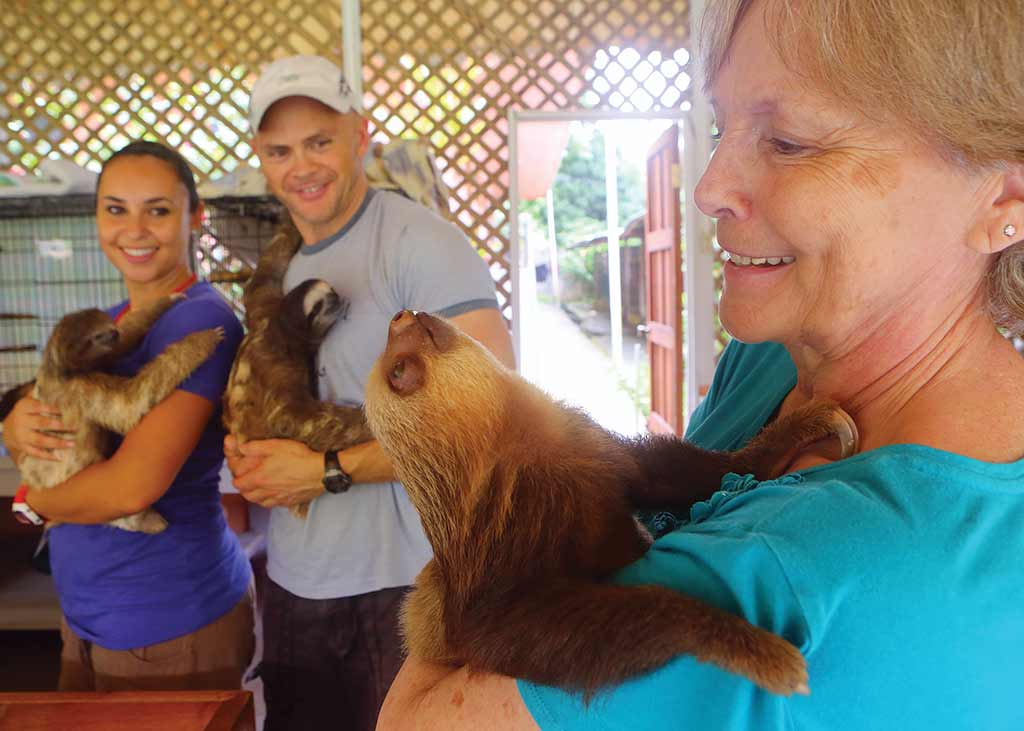South of Puerto Limón, the shore is lined by brown-sand beaches fringed by palms. About 30 kilometers (19 miles) south of Limón, the road crosses the Río Estrella a few kilometers north of the village of Penshurst, where a branch road leads into the Valle del Río Estrella. The valley is blanketed by banana plantations of the Dole Standard Fruit Company, headquartered at Pandora, about six kilometers (4 miles) inland of Penshurst. The Río Estrella rises in the foothills of the steep-sided, heavily forested Talamanca massif, and it irrigates the banana plantations as it crosses the broad plains in search of the Caribbean. The river estuary forms a dense network of channels and lagoons that shelter birds, including great flocks of snow-white cattle egrets.

Judy Arroyo with rescued sloths at the Sloth Sanctuary. Photo © Christopher P. Baker.
Guided two-hour tours (hourly on the hour 8am-2pm Tues.-Sun., adult $25, ages 5-11 $15, under age 5 free) begin with an excellent video and include a one-hour canoe trip in the freshwater lagoons and marshes of the Estrella delta—a great place to spot caimans, river otters, monkeys, and other wildlife. A special behind-the-scenes Insider Tour costs $150, by reservation.
The private 950-hectare (2,350-acre) Selva Bananito Lodge & Reserve (Conselvatur, tel. 506/2253-8118 in San José or tel. 506/8375-4419), 15 kilometers (9.5 miles) inland from Bananito Norte—five kilometers (3 miles) inland of the coast road—protects primary rainforest on the slopes of the Talamancas. Activities such as bird-watching, nature hikes, horseback riding, and waterfall rappels are offered.
The reserve is tough to reach, but worth the effort if you’re seeking an off-the-beaten-track eco-focused adventure. A high-clearance 4WD is essential for the muddy track and for fording the river just before you arrive. Signs guide the way. During heavy rains or after a prolonged rainy season, you should arrange in advance to meet reserve guides at Salón Delia in Bananito. To get there, turn right off the main highway about one kilometer (0.6 miles) south of the Río Vizcaya (18 km/11 miles south of Limón) for Bananito. Beyond Salón Delia, cross the railroad track, then a creek, and take the left fork at a Y-junction, from where the lodge is signed. There are gates to be opened (and closed behind you), and a final river to cross, then a final rugged section to reach the lodge.
Undeveloped and off the beaten track, the 9,050-hectare (22,400-acre) Reserva Biológica Hitoy-Cerere (tel. 506/2795-1446, 8am-5pm daily, $10), part of the Parque Internacional La Amistad, is one of the nation’s least-visited parks. It is surrounded by three reservations for indigenous people—Talamanca, Telire, and Estrella.
Take your pick of arduous trails or moderately easy walks from the ranger station along the deep valley of the Río Hitoy-Cerere to waterfalls with natural swimming holes. The park is a starting point for trans-Talamanca journeys to the Pacific via a trail that leads south to the village of San José Cabecar and up the valley of the Río Coén and across the saddle between Cerro Betsú (2,500 meters/8,200 feet) and Cerro Arbolado (2,626 meters/8,615 feet) to Ujarrás, in the Valle de El General. Large sections have not been explored, and trails into the interior are overgrown, unmarked, and challenging (indigenous guides are available for local hikes).
Rainfall is prodigious: 700 centimeters (275 inches) in a year is not unknown, and March, September, and October are usually the driest months. The result: one of the best specimens of wet tropical forest in the country.
You can reserve basic lodging at the ranger station; researchers get priority. Camping is permitted, and there are basic showers and toilets. The park is signed from Pandora. You’ll need a 4WD vehicle if you’re driving.
Excerpted from the Tenth Edition of Moon Costa Rica.